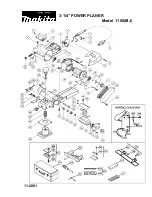
9
PLANING
See Figure 6.
■
Clamp the workpiece securely.
■
Adjust the planing depth. Refer to Planing Depth earlier
in this manual.
■
Hold the depth adjustment knob with one hand and the
handle with your other hand.
WARNING
Always use two hands on the tool for any operation;
this assures that you maintain control and avoid risk
of serious personal injury. Always properly support
and clamp the workpiece so that both hands are free
to control the planer. Never operate the tool overhead
or inverted from the proper operating position; serious
personal injury may result.
■
Place the front shoe on the edge of workpiece to be
planed.
NOTE:
Make sure the blades are not touching the
workpiece.
■
Apply pressure to the depth adjustment knob so that
the front shoe is completely flat on the workpiece.
■
Start the planer and let the motor reach maximum
speed.
■
Hold the planer firmly and push it forward into the
workpiece, using a slow, steady motion.
■
Apply downward pressure toward the rear handle as
you reach the end of the planed cut. This helps keep
the rear section of the planer base in contact with the
workpiece and prevents the front of the planer from
gouging the cut.
WARNING
Be careful to avoid hitting nails or staples during planing
operation; this action could nick, crack, or damage
blades.
NOTE:
We suggest that you always keep an extra set
of blades on hand. As soon as the blades in the planer
show signs of becoming dull, replace them. The blades are
reversible and can be reversed until both sides become
dull.
CHAMFERING
See Figure 7.
The planer is designed with a chamfering groove in the
front shoe to chamfer corners of boards as shown. Before
making a cut on good lumber, practice cutting on scrap
lumber to determine the amount to be removed.
■
Clamp the workpiece securely.
■
Hold the depth adjustment knob with one hand and the
handle with your other hand.
■
Place the chamfering groove on the surface to be cut.
■
Start the planer and let the motor reach maximum
speed.
■
Hold the planer firmly and push it forward into the
workpiece, using a slow, steady motion.
■
Apply downward pressure to keep the planer flat at the
beginning and the end of the work surface.
PLANING EDGES AND MAKING RABBET CUTS
The planer comes with an adjustable edge guide for
precision edge planing and rabbet cutting. Attach the edge
guide to either side of the planer for planing edges and
attach the edge guide to the left side for making rabbet
cuts.
ATTACHING THE EDGE GUIDE FOR PLANING EDGES
See Figure 8.
■
Unplug the planer.
■
Attach the bracket to the desired side of the planer and
tighten the knob bolt securely.
■
Attach the edge guide to the bracket using the knob nut
and the carriage head bolt.
■
Tighten the knob nut securely.
PLANING EDGES
See Figure 9.
Follow the directions in the Planing section earlier in this
manual. Hold the edge guide
fi
rmly against the edge of the
workpiece surface.
ATTACHING THE EDGE GUIDE FOR MAKING RABBET
CUTS
See Figure 8.
■
Unplug the planer.
■
Attach the bracket to the left side of the planer and
tighten the knob bolt securely.
■
Attach the edge guide loosely to the bracket using the
knob nut and the carriage head bolt (do not tighten).
■
Adjust the edge guide to the desired width for the
rabbet cut.
■
Tighten the knob nut securely.
TO MAKE RABBET CUTS
See Figure 10.
Follow the directions in the Planing section earlier in this
manual. Rest the edge guide
fi
rmly against the edge of the
workpiece surface.
The depth of the rabbet is determined by the depth of the
cut and the number of passes made along the work surface.
The maximum depth of the rabbet cut is 12 mm. The width
of the rabbet cut is adjustable by moving the edge guide.
Summary of Contents for RPL780
Page 1: ...ORIGINAL INSTRUCTIONS Planer RPL780...
Page 3: ...1 5 1 2 3 4 6 7 9 10 11 8...
Page 4: ...2 Fig 2 Fig 1 6 12 11 9 13 1 4 7 Fig 3 Fig 4...
Page 5: ...3 Fig 6 Fig 5 5 14 15 16 17 18 19 Fig 7 Fig 8...
Page 6: ...4 Fig 10 Fig 12 Fig 11 Fig 9 20 21 21 22 8...
Page 7: ...5 Fig 14 Fig 16 Fig 15 Fig 13 23 24 23 24 26 27 28 20 25...
Page 15: ......


































